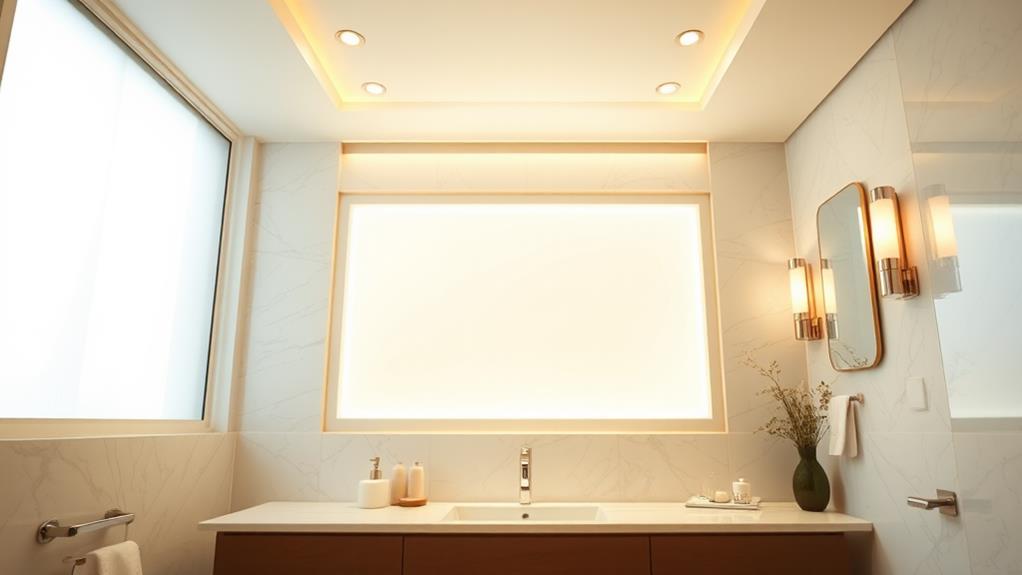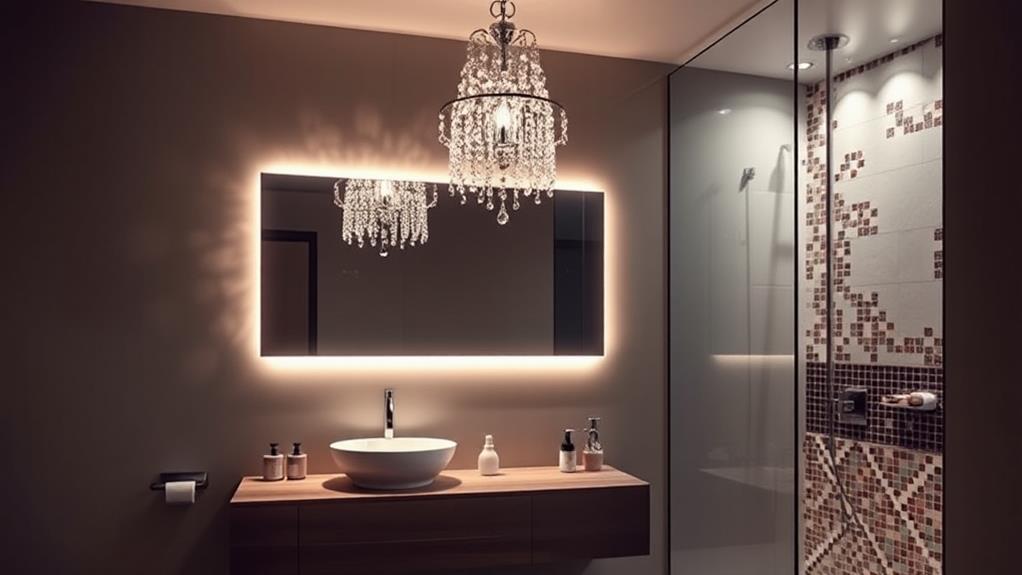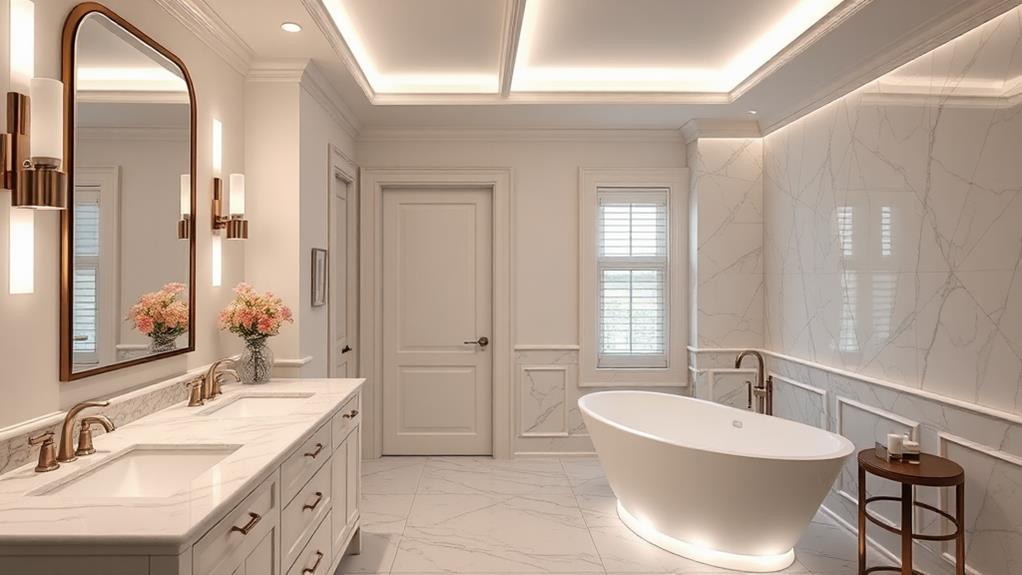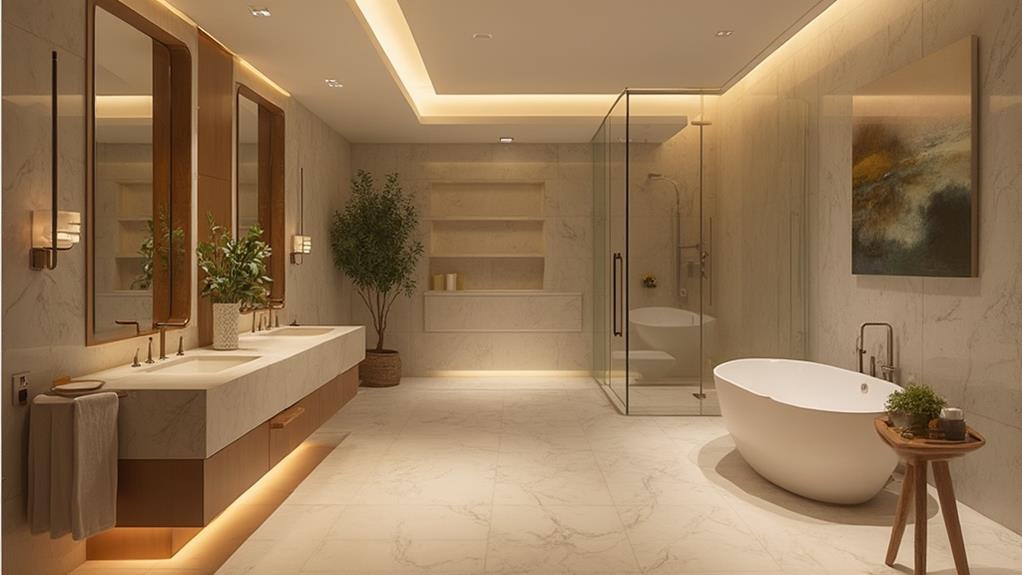When designing your bathroom lighting, you'll want to incorporate three essential layers: ambient, task, and accent illumination. Ambient lighting provides overall illumination, typically through ceiling fixtures. Task lighting focuses on specific areas like the vanity, ensuring proper visibility for grooming activities. Accent lighting adds depth and visual interest, highlighting architectural features or decor. By combining these layers effectively, you'll create a well-balanced and functional lighting scheme that enhances both the aesthetics and usability of your bathroom. Consider factors like fixture placement, color temperature, and energy efficiency to achieve the perfect balance. Dive deeper to unlock the full potential of layered bathroom lighting.
Understanding Ambient Lighting

When it comes to bathroom lighting, ambient lighting forms the foundation of your overall illumination strategy. This type of lighting provides general illumination for the entire space, creating a comfortable and welcoming atmosphere. You'll typically achieve ambient lighting through ceiling-mounted fixtures, such as recessed lights, flush-mount fixtures, or even chandeliers for larger bathrooms.
To effectively implement ambient lighting, consider the size and layout of your bathroom. For smaller spaces, a single central fixture might suffice, while larger bathrooms may require multiple sources to ensure even coverage. The color temperature of your ambient lighting is crucial; opt for warmer tones (2700K-3000K) for a cozy feel or cooler tones (3500K-4000K) for a more energizing atmosphere.
Don't forget about dimmers for your ambient lighting. They allow you to adjust the intensity based on the time of day or your mood. When selecting fixtures, ensure they're rated for use in damp environments. Lastly, consider how natural light interacts with your ambient lighting to create a harmonious blend throughout the day.
Task Lighting Essentials
While ambient lighting sets the overall mood, task lighting focuses on specific areas where you need enhanced visibility. In your bathroom, task lighting is crucial for activities like shaving, applying makeup, or grooming.
The most common and effective task lighting solution is to install lights on either side of your mirror. This setup minimizes shadows and provides even illumination across your face.
Consider using sconces or vertical fixtures at eye level for optimal results. If you're limited on wall space, you can opt for a horizontal light bar above the mirror. However, be cautious of overhead lighting alone, as it can cast unflattering shadows.
For your vanity area, aim for about 75-100 watts of illumination. LED bulbs are an excellent choice due to their energy efficiency and long lifespan. Look for bulbs with a color temperature between 2700K and 3000K for a warm, flattering light.
Don't forget task lighting for your shower or bathtub area. Recessed lighting with a waterproof trim is a practical solution. If you have a separate water closet, include task lighting there as well to ensure adequate illumination throughout your entire bathroom space.
Accent Lighting for Visual Interest

Accent lighting adds depth and character to your bathroom, transforming it from a purely functional space into a visually appealing retreat. It's the final layer that brings your bathroom's design to life, highlighting architectural features, artwork, or decorative elements.
Consider using LED strip lights to create a soft glow behind your mirror or under floating vanities. This not only adds visual interest but also serves as a subtle nightlight. Wall sconces can accentuate textured walls or frame a statement mirror, while recessed spotlights can draw attention to shelving units or artwork.
Don't overlook the potential of pendant lights as accent pieces. Hung at varying heights, they can create a dramatic focal point over a freestanding tub. For a touch of luxury, install a small chandelier to add sparkle and sophistication.
Uplighting is another effective technique. Place fixtures on the floor to illuminate plants or sculptural elements, creating intriguing shadows and depth. Remember, accent lighting should be about three times brighter than your ambient lighting to create the desired effect. By strategically placing these accent lights, you'll enhance your bathroom's atmosphere and showcase its best features.
Combining Lighting Layers Effectively
Harmony is key when combining different lighting layers in your bathroom. To achieve a balanced and functional lighting scheme, you'll need to consider how ambient, task, and accent lighting work together.
Start by ensuring your ambient lighting provides an overall illumination that's neither too harsh nor too dim. This sets the foundation for the other layers.
Next, incorporate task lighting where it's most needed, such as around the mirror for grooming activities. Make sure these lights don't create harsh shadows or glare.
Accent lighting should complement the other layers, highlighting architectural features or artwork without overpowering the space.
Use dimmers to control the intensity of each layer, allowing you to adjust the lighting based on time of day or specific needs. Consider color temperature consistency across all layers to maintain a cohesive look. Warm white light (2700-3000K) is generally flattering for bathrooms.
Don't forget to balance natural and artificial light. If you have windows, integrate your lighting plan with daylight to create a seamless transition throughout the day.
Choosing the Right Fixtures

When selecting fixtures for your bathroom lighting, it's crucial to consider both function and style. For ambient lighting, choose recessed ceiling lights or flush-mount fixtures that provide even illumination throughout the space. Opt for dimmable options to adjust the brightness as needed.
For task lighting around the mirror, consider wall-mounted sconces on either side or a horizontal vanity light above. These fixtures should be placed at eye level to minimize shadows on your face. LED options are energy-efficient and provide crisp, clear light for grooming tasks.
Accent lighting can include decorative pendant lights, chandeliers, or wall sconces that complement your bathroom's design. Use these fixtures to highlight architectural features or artwork.
When choosing fixtures, ensure they're rated for bathroom use and can withstand moisture. Look for fixtures with an IP rating of at least IP44 for areas near water sources. Consider the finish of your fixtures, selecting options that match your bathroom's hardware and overall style.
Don't forget about natural light. If possible, incorporate windows or skylights to provide a pleasant daytime ambiance and reduce your reliance on artificial lighting during the day.
Energy-Efficient Lighting Solutions
Energy efficiency is a key consideration when choosing bathroom lighting. LED bulbs are your best bet for maximizing energy savings while providing excellent illumination. They consume up to 75% less energy than traditional incandescent bulbs and last significantly longer. When selecting LED lights, look for those with a high Color Rendering Index (CRI) to ensure accurate color representation.
Smart lighting systems offer another energy-efficient solution. These allow you to control your bathroom lights remotely, set schedules, and adjust brightness levels. You can program them to turn off automatically when the room is unoccupied, reducing unnecessary energy consumption.
Consider installing occupancy sensors or motion detectors to further minimize energy waste. These devices automatically turn lights on when someone enters the bathroom and off when they leave. Dimmer switches are another excellent option, allowing you to adjust light levels based on your needs and time of day.
Don't forget about natural light. Maximize daylight by using light-colored window treatments or installing skylights. This can reduce your reliance on artificial lighting during daytime hours. For nighttime use, opt for warm-toned bulbs with lower color temperatures to promote relaxation and maintain your circadian rhythm.
Conclusion
You've mastered the art of layered bathroom lighting, but what's next? As you stand in your transformed space, bathed in the perfect blend of ambient, task, and accent illumination, you can't help but wonder: what other rooms could benefit from this newfound knowledge? The possibilities are endless. Will you tackle the kitchen next, or perhaps the living room? One thing's certain: your home will never look the same again.

